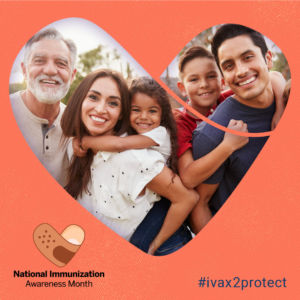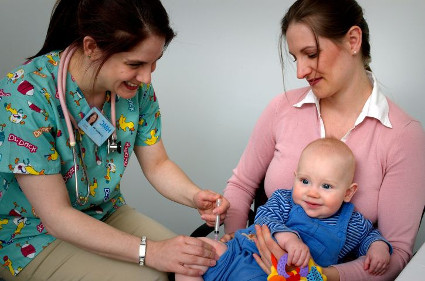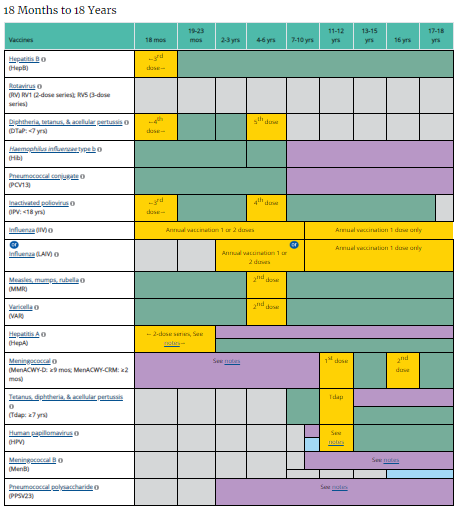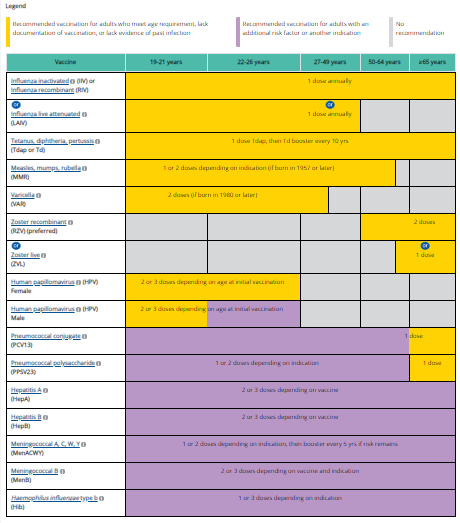August is National Immunization Awareness Month
 August is National Immunization Awareness Month (NIAM) where we observe and highlight the importance of vaccinations for people of all ages. These immunizations aid in the prevention of serious, and even deadly, diseases throughout our lives.
August is National Immunization Awareness Month (NIAM) where we observe and highlight the importance of vaccinations for people of all ages. These immunizations aid in the prevention of serious, and even deadly, diseases throughout our lives.
Despite current controversies of whether to vaccinate someone or not, vaccinations have proven their worth by nearly eradicating several deadly diseases, such as small pox, polio and tuberculosis. They have also prevented widespread epidemic proportions of serious diseases like measles, meningitis, and the flu.
Vaccinations For Children
Most of us receive a series of vaccinations in our infant and childhood years to help protect from a variety of illnesses or reduce the severity of the disease if infected. Vaccinations are usually administered within a certain timeline and may require a series of injections to complete the immunizations process. Others may require boosters to help keep that immunity moving into adulthood. Medical professionals usually follow the Centers for Disease Control (CDC) immunization schedule to determine what vaccinations are necessary and at what time in our life they are recommended.
Parents can choose whether to vaccinate their infant or child from many serious and deadly diseases they could contract in their early years. There is much controversy whether vaccinations help or harm children. Unfortunately, there is not enough research out there to conclusively prove that vaccinations are harmful, such as contributing to autism in children. However, vaccinations given to the general populace over the years have helped eradicate diseases and prevented children from dying prematurely from diseases now easily controlled.
Children in Public School

If you choose to place your child(ren) in a public daycare or early learning facility, many will require proof of vaccinations before allowing them to attend. Children are in confined quarters for many hours per day where childhood diseases, such as the flu and colds run rampant.
While building immunity for illness in this setting is not a bad thing, one can see how non-vaccinated children could easily spread a highly contagious disease throughout the facility and then into other public areas. In very little time an epidemic could break out causing panic and even death to other susceptible children or vulnerable adults.
By the time your child reaches public school, immunizations are required for attendance. If your child is not fully up-to-date on their shots the school will deny them access to the public institution. See the recommended immunization schedule below from the CDC for infants up to 18 years of age. (1)

Vaccinations for Adults
Vaccinations don’t stop after you reach age eighteen. Several boosters are needed to help keep the immunity we have built over the years. These vaccinations will continue to protect us through our senior years and include conditions such as tetanus, diphtheria and pertussis.
Influenza Vaccine
Those who are younger than five, older adults (65 and older), pregnant women and people with certain long-term medical conditions like asthma, heart disease and diabetes, should consider getting an annual influenza, or flu, shot. This will help minimize serious flu strains that appear each year in the colder months that could cause serious complications, including death.
Here is a list from the CDC on recommended vaccinations for adults, including suggested vaccinations if you missed them in your childhood years. (2)

Shingles Vaccine
Adults 50 years and older are recommended to receive the shingles vaccine. If you have had chickenpox then you are at risk for developing shingles (herpes zoster virus). It is not known what reactivates the virus, but shingles is a painful rash that appears as a striping of blisters on the trunk of the body, but can appear on the chest, arms and even the face. Pain can still persist once the rash is gone. It can take weeks for the shingles to disappear. Having the varicella vaccine (chickenpox) as a child will reduce the risk of contracting shingles and minimize the infection if it reactivates.
Personal note: my wife’s father had chickenpox as a child and then contracted shingles twice in his later years. Both bouts of shingles were very painful and lasted well over a month with a wide band of oozing blisters all around his midriff area. He did not get the shingles vaccination as the family suggested and suffered greatly, twice in fact, for that decision.
Here is a good video explaining the signs, symptoms, prevention, risks and treatment for shingles:
Pneumococcal Vaccines
Adults 65 and older are also recommended to receive both pneumococcal vaccines. Some adults younger than 65 years with certain conditions are also recommended to receive one or more pneumococcal vaccinations.
Adults may need other vaccines (such as hepatitis A, hepatitis B and HPV) depending on their age, occupation, travel, medical conditions, vaccinations they have already received or other considerations
August is National Immunization Awareness Month Summary
 We all must make our own informed decision on whether to accept any or all recommended vaccinations from the CDC for ourselves and for our children. In making that decision we must take into account the requirements of public daycare and educational systems in allowing only fully vaccinated children to enroll and attend school.
We all must make our own informed decision on whether to accept any or all recommended vaccinations from the CDC for ourselves and for our children. In making that decision we must take into account the requirements of public daycare and educational systems in allowing only fully vaccinated children to enroll and attend school.
Disease will spread quickly, and we have seen this just in this past year with the resurgence of measles on both coasts. This can have negative consequences for those in a close-knit settings such as schools, daycare facilities, assisted living center and rehabilitation facilities where some of our most vulnerable populations frequent or live.
We must also consider the protection it provides not only for us but for those we come into contact with each day. Do we want to spread disease and infection to others, especially our loved ones, if there is a proven vaccination for it? The varicella and shingles vaccinations are a good example of how a childhood disease can lead to a very painful infection as a senior and vice versa. Following through on your immunizations according to the recommended schedule from the CDC will help ensure we protect ourselves and our loved ones from spreading or contracting some of the easiest curable diseases in our world today.
Note: NIAM is sponsored by the National Public Health Information Coalition (NPHIC).
To your improved health!
Resources:
- Centers for Disease Control – National Immunization Month
- National Public Health Information Coalition (NPHIC) – National Immunization Awareness Month
References:
- (1) – Centers for Disease Control – Immunization Schedules from Birth to 18 years of Age
- (2) – Centers for Disease Control – Immunization Schedule for Adults

